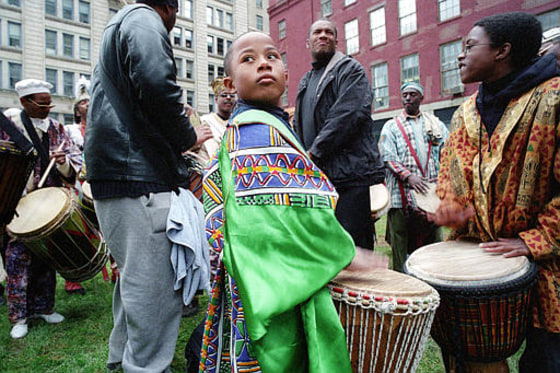"It's a special day, solemn and significant," Jim Huffman, 52, a New York librarian, said Saturday as drummers in traditional African kente cloth provided a musical backdrop for the crowd.
The remains had been uncovered in 1991 during construction of a federal office tower in lower Manhattan.
Under pressure from the community, the government abandoned the work and began examining what they had found. The site turned out to be a five-acre burial ground that had been closed in 1794 and long forgotten. It was the final resting place for an estimated 20,000 people of African descent.
The reinterrment ceremony Saturday marked the end of a long struggle to have the African Burial Ground recognized.
David Dinkins, the city's first black mayor, pointed out during ceremonies held Friday that the burial ground was located outside the limits of 18th-century New York City, evoking a kind of apartheid even in death.
"Two centuries ago, not only could African Americans not hope to govern New York City, they could not hope to be buried in the city limits," Dinkins said.
Four sets of the remains _ a boy, girl, woman and man _ were returned to New York on Friday after being honored this week in Washington, D.C., Baltimore, Wilmington, Del., and Newark, N.J.
People wept Friday as the four wooden coffins _ accompanied by five other horse-drawn carriages carrying more than 300 others _ proceeded slowly from the South Street Seaport near Wall Street and up Broadway to the site.
About half of the 419 sets of remains belong to children; one woman was interred with an infant cradled in her right arm. Researchers have studied the remains over the past decade, and an initial report is due in November.
Mayor Michael Bloomberg told an audience of about 1,000 people Friday that the South Street Seaport, now filled with shops catering to tourists, had once been the site where slaves were auctioned.
"Once, African Americans of our city were bought and sold on this very spot," Bloomberg said. "It's fitting that this is where we are receiving them. As mayor of New York, I welcome them home. May they rest in peace, the peace they so richly deserve."
Dr. Michael Blakey, the African Burial Ground study director, revealed a bit of information Friday about the slaves who had been brought to New York City in the 18th century.
They came from across Africa, from Nigeria to Madagascar, were mostly male between 15 and 25, and were brought to New York after a stopover in the Caribbean Islands to "season" them, Blakey said, meaning they were tortured to break their spirit.
Once in New York, they lived in poor housing, ate nothing but cornmeal porridge, lard and bread, Blakey said. But the slaves were able to meet secretly to organize rebellions, he added.
During one rebellion, the slaves were joined by several whites, said state Sen. David Paterson, who established a task force in 1991 to oversee the burial ground.
"In 1741, there was a slave revolt and some whites fought with the slaves. Their punishment was to be hung and buried with blacks," he said. "This is not just African American history, but American history."
